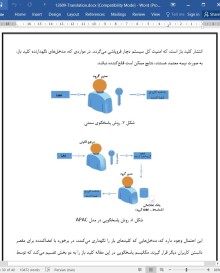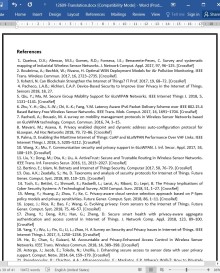
دانلود مقاله eHAPAC: مدل حفظ حریم خصوصی کنترل دسترسی در شبکه های حسگر بی سیم
چکیده
پیاده سازی فناوری IP در شبکه های حسگر بی سیم باعث توسعه بسیاری از سناریوهای هوشمند شده است.. به منظور افزایش دسترسی امن در شبکههای WSN مبتنی بر IP، کنترل دسترسی در گرههای حسگر به عنوان مرحله مهمی است. به هر حال، در حال حاضر، کنترل دسترسی با دو چالش روبرو است، که عبارتند از قابلیت اجرا، و حفظ حریم خصوصی دسترسی کاربر. در این مقاله، به معرفی مدل eHAPAC میپردازیم، که به عنوان یک مدل حفظ حریم خصوصی کنترل دسترسی در شبکههای حسگر بیسیم (یا WSN) مبتنی بر IP است. مباحث این مقاله شامل سه بخش است. ابتدائا، این مقاله به ادغام پروتکل کنترل دسترسی هیدرا و مدل حفظ حریم خصوصی APAC میپردازد که معرف حفظ حریم خصوصی کنترل دسترسی دستگاههایی با منابع محدود میپردازد. دوم اینکه، این مقاله به معرفی یک پروتکل هیدرا پیشرفته برای پیادهسازی پیوندناپذیری تبادلات پیام پروتکلی میپردازد. سوم، به منظور حل مسئله اعتبار شخص ثالث، این مقاله به توسعه مدل APAC مبتنی بر امضا گروهی پرداخته، و از فناوری بلاکچین برای مدیریت ذخیرهسازی و انتشار کلید عمومی امضا گروهی استفاده میکند. تحلیل امنیتی و ارزیابی عملکرد، اثبات میکند که پروتکل مورد نظر ما امن و کارامد است.
1. مقدمه
شبکههای حسگر بیسیم (WSNها) به عنوان بخش مهمی از اینترنت اشیا (IoT) ، باعث ایجاد محیطهای هوشمند میشوند. این شبکه معمولا متشکل از هزاران حسگر کوچک، کمخرج، با مصرف توان پایین، و با منابع محدود است که شرایط محیطی همچون دما، پارازیت، نور، یا یا حرکت اشیا را نشان میدهد. به دلیل کمهزینه بودن آن، شبکههای WSN دارای کاربرد گستردهای در حوزههایی همچون شناسایی نظامی، نظارت صنایع، مراقبتهای بهداشتی، و حوزههای دیگر هستند [1,2]
به هر حال، همچنان مشکلات زیادی همچون، مقیاسپذیری پایین، و خرابی تکنقطهای، در شبکههای WSN سنتی وجود دارد [4]، [5]. اخیرا، به واسطه ایجاد راهحلهایی همچون استاندارد 6LoWPAN، مشکلاتی که باعث انسداد یکپارچهسازی بومی حسگرها و اینترنت میشد (همچون پردازش بالاسری هدر IPv6، انتقال بسته، و غیره روی شبکه IEEE 802.15.4)، حل شده است [5]، [7]. ارتباط مستمر (E2E) بین کاربران اینترنت و گرههای حسگر واقعا به تحقق پیوسته است که باعث افزایش کاربرد شبکههای WSN شده است. اما بحران امنیتی جدید برای شبکههای WSN مبتنی بر IP ایجاد شده که فرد مهاجم میتواند به سادگی به دادههای گرههای حسگر از طریق آدرسدهی سراسری، دسترسی پیدا کند [8]، [10]. بعلاوه، آسیبپذیری بالای خود شبکه WSN (به عنوان نمونه، به دلیل منابع محدود) باعث میشود که بسادگی به عنوان هدف بسیاری از حملات امنیتی (از طریق هک، دزدی داده، سرقت از راه دور قرار گیرد [3]، [11]، یا به عنوان ابزاری برای هکرها به منظور اجرای حملات امنیتی باشد [12] ( به عنوان نمونه، شبکه میرا متشکل از دستگاههای IOT (اینترنت اشیا) است که باتنتهایی در سطوح میلیونی ایجاد میکند و منجر به حملات دیداس روی موسسه KrebsonSecurity شد. بنابراین، دسترسی به گرههای حسگر باید به شدت در شبکه WSN میتنی بر IP کنترل گردد. مدل کنترل دسترسی مبنا شامل سه بخش است: تایید، مجوز، و وارسی [13]. معمولا، مرحله تایید، و مجوز شامل انتقال اطلاعات هویتی کاربر به سرویس هدف است، که خود موجب مشکل دیگری تحت عنوان امنیت حریم خصوصی دسترسی داده، میگردد. در حال حاضر، روش دسترسی کاربر به عنوان هدف گرداوری داده قرار میگیرد [13]که از این طریق الگو و اولویت روش کاربر را مشخص میکند، که باعث تهدید حریم خصوصی کاربر چه از نظر مادی و چه معنوی میگردد [14] [18]. بنابراین، اجرای کنترل دسترسی در شبکههای WSN مبتنی بر IP، بدون آشکارسازی حریم خصوصی کاربر، امری ضروری است.
7. نتیجهگیری
چالش اصلی در ارتباط با دسترسی از راه دور امن به RCDهای مبتنی بر پروتکل اینترنتی، وجود راهحلهای کنترل دسترسی عملی و حفظ حریم خصوصی دسترسی به داده کاربر است. این مقاله به ایجاد مدل حفظ حریم خصوصی کنترل دسترسی eHAPAC برای شبکههای WSN مبنی بر پروتکل اینترنتی، و محیطهایی با منابع به شدت محدود میپردازد. این مقااله، به توسعه پروتکل دسترسی معتبر هیدرا با تبادل پیام پیوندناپذیر میپردازد. این مقاله به بهبود امضا گروهی مبتنی بر حفظ حریم خصوصی مدل کنترل دسترسی APAC، از طریق ایجاد دو گروه ثالث محدود متقابل، به منظور پیشگیری از جاسوسی و تفلب شخص ثالث میپردازد. مدل پیشنهادی به تضمین حریم خصوصی دسترسی داده کاربر، بدون افشای ان برای هر نهاد دیگر به ویژه گروههای ثالثی که در پروتکلهای امنیتی مشارکت دارند، میپردازد، که این فرایند باعث عملی تر شدن این رویکرد میگردد. این مقاله به اصلاح الگوی امضا گروه XSGS پرداخته و از ان به عنوان مثالی برای توصیف مراحل پیادهسازی مدل پیشرفته حفظ حریم خصوصی استفاده میکند. به هر حال، همچنان مشکلاتی نیز وجود دارد: این روش قادر به مقاومت در برابر حملات به منابع نیست؛ پاسخگویی مراحل امضا گروهی نمی تواند فراتر از سطح مورد انتظار باشد، که به سادگی منجر به بروز اختلافاتی میگردد؛ و مدیریت و روشهای انتشار کلیدهای عمومی گروه، به اندازه کافی انعطافپذیر نیستند. بدین منظور، این مقاله به معرفی فناوری بلاکچین پرداخته و به طراحی یک قرارداد هوشمند برای حل این مشکلات با توجه به خصوصیات توزیع، شفافیت و برگشتناپذیری بلاکچین میپردازد. تحلیل امنیتی نشان میدهد که، مدل پیشنهادی میتواند به تامین اهداف امنیتی مورد نظر بپردازد. از طریق شبیهسازیهای تجربی و تحلیل عملکرد مدل پیشنهادی، اثبات میگردد که مدل پیشنهادی عملی و منطقی است.
Abstract
The implementation of IP technology in wireless sensor networks has promoted the development of many smart scenarios. To enhance secure access in IP-enabled wireless sensor networks, access control to sensor nodes is a necessary process. However, access control currently faces two challenges, feasibility and preservation of user access privacy. In this paper, we propose eHAPAC, a novel privacy-preserving access control model for IP-enabled wireless sensor networks. The contributions of our paper include three parts. First, this paper integrates the Hidra access control protocol and APAC privacy-preserving model, addressing the issue of privacy-preserving access control in resource-constrained devices. Second, this paper proposes an enhanced Hidra protocol to implement the unlinkability of protocol message exchanges. Third, to solve the problem of third party credibility, this paper improves the group signature-based APAC model and utilizes blockchain technology to manage the storage and publication of public group signature keys. Security analysis and performance evaluation prove that our protocol is secure and effective.
1. Introduction
Wireless sensor networks (WSNs), as an important part of the Internet of Things (IoT), enable us to create smart environments. They are typically composed of thousands of tiny, low-cost, low-power, resourced-constrained sensors that detect environment conditions such as temperature, noise, light, or the movement of objects. With their low cost, WSNs have been widely used in military reconnaissance, industrial monitoring, medical health care and other fields [1,2].
However, there are still many problems in traditional WSNs, such as poor scalability and single point of failure issues [3,4]. Recently, in virtue of the development of solutions like the 6LoWPAN standard, the problems which block the native integration of sensors and the Internet (e.g., IPv6 header overhead, packet transmission, etc. on the IEEE 802.15.4 network) have been solved [5–7]. The end-to-end (E2E) communication between Internet users and sensor nodes can really be realized, which promotes the application of WSNs. However a new security crisis has been introduced for IP-enabled WSNs whereby adversaries can more easily access data on sensor nodes by using global addressing [8–10]. Moreover, the high frangibility of the WSN itself (e.g., its resource constrained nature) makes it a easy target for many security attacks [3,11] (e.g., hacking, data theft, remote hijacking) or a tool for hackers to launch security attacks [12] (e.g., Mira, composed of IoT devices that constituted a million-level botnets, launched a crazy DDoS attack on Krebson Security). Therefore, the access to sensor nodes must be strictly controlled in IP-enabled WSNs. A basic access control model includes three components: authentication, authorization and auditing [13]. Generally, authentication and authorization imply transmitting user identity-related information to the targeted service, which will cause another problem, namely privacy security of data access. Currently, user access behavior is a target for data collection [13], from which users’ behavior patterns and preferences can be summarized, posing a threat to users’ privacy and even property and lives [14–18]. Therefore, it is necessarily to implement access control in IP-enabled WSNs without revealing users’ private information.
7. Conclusions
The key challenges for secure remote access to IP-enabled RCDs are the availability of feasible access control solutions and preserving user data access privacy. This paper establishes a privacy-preserving access control model eHAPAC for IP-enabled WSNs, a severely resourced-constrained environment. This paper enhances the formally validated Hidra access protocol with unlinkability of message exchanges. In the authorization phase, the self-renewed TGTs is used to prevent the authorization request messages from being linked. A fake ticket mechanism is introduced in the authorization response message to ensure the unlinkability between authorization request process and service access process. This paper improves the group signature-based APAC privacy-preserving access control model by setting up two mutually restrictive third parties to avoid third-party monitoring and cheating. The proposed model ensures user data access privacy without disclosure to any entity including the third parties participating in the security protocol, which makes it more practical. This paper modifies the XSGS group signature scheme and chooses it as an example to describe the implementation process of the enhanced privacy-preserving model. However, there are still some problems: it is unable to resist resource attacks, the accountability process of group signatures cannot be above board, which easily causes disputes, and the management and publishing methods of group public keys are not flexible enough. To this end, this paper introduces blockchain technology and designs a smart contract to solve these problems taking advantage of the distributed, transparent and irreversible attributes of the blockchain. In the system setup phase, blockchain acts as a platform for group public key management and publishing to increase the flexibility of public key management. In the authentication phase, blockchain serves as an intermediate platform for message exchange between ACS and users to resist resource consumption attacks on ACS. In the accountability phase, this paper proposes a new accountability mechanism based on blockchain, which makes the accountability process to prevent arbitration organizations from cheating, and makes the results more convincing. The security analysis shows that the proposed model can meet our expected security goals. Through experimental simulations and analyzing the performance of the proposed model, it is demonstrates that the proposed model is feasible and rationality.
چکیده
1. مقدمه
2. آثار مرتبط
3. بیان مسئله
3.1. معماری شبکه
3.2. مدل اعتماد و تهدید
3.3. اهداف امنیتی
4. ساختار EHAPAC
4.1 مرور کلی
4.2 مدل حفظ حریم خصوصی EHAPAC
4.2.1 تنظیمات سیستم
4.2.2 الحاق کاربر جدید
4.2.4 لغو عضویت کاربر
4.2.5 پاسخگویی و حل اختلافات
4.3 پروتکل کنترل دسترسی
4.3.1 مرحله تایید
4.3.2 مرحله تنفیذ
4.3.3.مرحله دسترسی سرویس و مرحله وارسی
4.4. طراحی قرارداد هوشمند
5. تحلیل امنیتی
5.1. مقاومت در برابر حمله به حریم خصوصی
5.2 مقاومت در برابر حملات تکراری
5.3 مقاومت در برابر حملات سرویس مصرف منابع
5.4. تضمین آزادی و شفافیت فرایند پاسخگویی
6. ارزیابی عملکرد
6.1 ارزیابی عملکرد پروتکل هیدرا پیشرفته
6.2 ارزیابی عملکرد مدل حفظ حریم خصوصی
7. نتیجهگیری
منابع
Abstract
1. Introduction
2. Related Work
3. Problem Formulation
3.1. Access Control System Architecture
3.2. Trust and Threat Model
3.3. Security Goals
4. eHAPAC Construction
4.1. General Overview
4.2. The Privacy-Preserving Model of EHAPAC
4.2.1. System Setup
4.2.2. New User Join
4.2.3. Sign and Verify
4.2.4. User Revokation
4.2.5. Accountability and Disputes Resolution
4.3. Access Control Protocol
4.3.1. The Authentication Phase
4.3.2. The Authorization Phase
4.3.3. The Service Access Phase and The Auditing Phase
4.4. Smart Contract Design
5. Security Analysis
5.1. Resisting Privacy Attacks
5.2. Resisting to Replay Attacks
5.3. Resisting to Resource Consumption Attacks
6. Performance Evaluation
6.1. Performance Evaluation of the Enhanced Hidra Protocol
6.2. Performance Evaluation of the Privacy-Preserving Model
7. Conclusions
References
- ترجمه فارسی مقاله با فرمت ورد (word) با قابلیت ویرایش، بدون آرم سایت ای ترجمه
- ترجمه فارسی مقاله با فرمت pdf، بدون آرم سایت ای ترجمه



